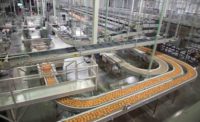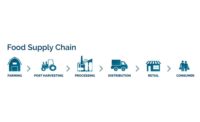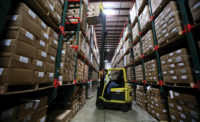Improving the food industry cold chain with interconnectivity
Food temperature monitoring and tracking technology reaches a new level.

courtesy of Master-Bilt

courtesy of American Thermal Instruments

courtesy of American Thermal Instruments

courtesy of Emerson

courtesy of BluLine Solutions

courtesy of Zebra Technologies






Cold-chain management—an essential aspect of many snack and bakery operations today—has entered a brave new world characterized by sophisticated temperature monitoring and tracking technology connected by the Internet of Things (IoT). At the same time, key government regulations are impacting this area and demanding additional focus on food safety.
What’s more, the cold-chain market is huge and growing. In fact, the global cold-chain market is projected to reach a value of $271.30 billion by 2022 with a CAGR of 7.0 percent, according to the “Cold Chain Market, Global Forecast to 2022” report issued by Markets and Markets.
This projected increase can be attributed to the growth of international trade of perishable foods, technological advances in refrigerated storage and transport, government support for infrastructure development of the cold-chain industry and increased consumer demand for perishable foods, the report states.
Bakers are moving more aggressively into cold and frozen storage, according to Robb MacKie, president and CEO, American Bakers Association, Washington, D.C. “In the middle of the recent IBIE conference, the McDonald’s supply chain announced a move toward even greater reliance upon frozen storage and delivery of bakery and other products. While it is still early, this trend that started in Europe is likely to expand in the U.S.”
Impact of regulations
The Sanitary Transportation of Food Rule, a component of the Food Safety Modernization Act (FSMA), will continue to impact all companies that store and transport food products. Traceability will continue to become more important as the regulation proceeds.
The traceability changes due to FSMA implementation mean that cold-storage facilities and transportation providers need to ensure that their systems are providing required data and information, says Eric Pfeiffer, senior director, supply chain integration, HAVI, Downers Grove, IL. “This will require system upgrades that enable the tracking of products not only at the storage location, but one step back and one step forward in the supply chain.”
The FDA’s passing of FSMA, Rule 111, in 2011 continues to trigger investments in asset tracking and management solutions to document every step in the food supply chain. “Per that ruling, food products must be traceable all the way back to the point of origin. Recall systems must be reliable and efficient, not only to rapidly comply with more regulations, but to limit the scope by isolating specific batches of product if there is a safety issue,” says Bill Cusack, director of transportation and logistics marketing strategy, Zebra Technologies, Lincolnshire, IL.
On the equipment side, Master-Bilt, New Albany, MS, has designed all of its self-contained refrigeration products, including reach-ins and all other applicable refrigerated cabinets, to meet new Department of Energy 2017 requirements, according to Lynn Burge, advertising and promotion manager.
Another government regulation that affects refrigeration is the EPA’s Significant New Alternatives Policy (SNAP), which calls for the delisting of certain widely used HFC refrigerants, including R-404A and R-134a. “Master-Bilt, as a part of the Standex Refrigerated Solutions Group, has developed the Alternative Industrial Refrigerants Initiative in response. It outlines the use of HFO-blended refrigerants and foaming agents to meet SNAP guidelines as the best possible solution for our customers,” Burge says.
Tech innovations
New technologies that maintain and track temperatures for finished products from the warehouse through distribution to the end customer embrace the IoT. Data logging is an important part of this equation.
“More and more, we see companies that specialize in the use of monitoring devices to track the status of shipments. The trend has gone beyond the basic capability of an onboard temperature recorder, with results being available at the termination of the shipment. New technologies leverage the IoT to track and communicate shipment status dynamically,” Pfeiffer says. “For cold-chain transport, the use centers on assuring temperature parameters. Other systems being developed can provide updates on shipment location, product shock, gas emissions, light exposure, humidity and container tipping.”
Among recent innovations, LOG-IC 360 electronic data loggers from American Thermal Instruments, Dayton, OH, provide easy access to temperature data, ensuring that food arrives at a consistent, safe temperature. By adding the company’s DataNow app technology, users can gain immediate access to temperature records. They can sort, download and analyze data and see where deviations may have occurred.
“The biggest advance we have made is to utilize our customers’ existing infrastructure to handle cold-chain issues. Products that communicate through NFC (near field communication) or Bluetooth 4.0 are taking over. It’s easier to communicate without physically handling data loggers. It also allows the platform to connect effortlessly to data management systems throughout the cloud,” says Randy Lane, chief strategy officer, American Thermal Instruments.
American Thermal Instruments also offers chemical temperature indicators that provide immediate notification if a perishable or frozen food item has hit a temperature deviation. This ensures that any food product stays within temperature range throughout its journey.
Emerson, St. Louis, has introduced AutoSense Facility, which monitors temperatures in stationary areas, such as storage and processing facilities, walk-in coolers and freezers, and cold cases. The system uses data loggers that wirelessly connect to a gateway, which links to the cloud using cellular connectivity. “It has minimal impact on existing networks, because it’s a complete drop-in system. It also offers temperature mapping and reporting capabilities, and generates text and email alerts if temperatures go out of range,” says Amy Childress, vice president marketing, cargo solutions.
In addition, Emerson offers data loggers and trackers for end-to-end monitoring of products in transit. These include temperature monitoring labels and real-time temperature and location trackers that use cellular connectivity to report data.
Incident alerts
Danfoss, Baltimore, MD, recently developed Cool.it, a technology platform designed to improve temperature control and transparency throughout the cold chain—from food production through transportation, warehousing, distribution and retail. The scalable, cloud-based system provides end-to-end product visibility and incident alerts.
By collecting real-time temperature data and utilizing easy-to-read dashboards—available on computers, mobile phones and tablets—the system facilitates the sharing of data and can help increase efficiency, reduce risk of food waste and improve traceability. As an open platform, Cool.it is compatible with temperature-monitoring solutions from various manufacturers.
BluLine Solutions, Pittsburgh, recently introduced the Blulog wireless temperature monitoring solution to North America. The solution includes RF data loggers that communicate over long distances to a gateway hub connected to the internet. They log critical temperature conditions in cold-storage facilities, and are suitable for grocery cold storage, retail display cases and refrigerated truck transport.
The company’s data loggers and temperature recorders operate on the same cloud system, a web portal interface where registered users can program the devices, download reports, and view charts and the geographic history of tracked products.
BluLine Solutions also offers ColdFinder, which is designed for retail cold storage. It works by integrating cloud-connected data loggers with cold-storage promotional product inventory. “Not only does the grocery store log their cold-storage conditions with ColdFinder, the system can serve as a promotional sales tool,” says Catherine Hornsby, chief marketing officer. Once the customer scans a QR code on the retail cold case to ensure that the product was stored at proper temperatures, they can receive cross-promotional merchandising product alerts or coupons.
Zebra Technologies is testing a food safety and monitoring solution that allows sensors to be paired with a product barcode to capture data such as temperature, humidity, shock and tilt to every shipment. For example, the solution could allow a company to monitor a food shipment and capture in near real time any changes during transport and distribution.
“The solution reports these changes via alerts and notifications to a handheld device used by the operator, as well as the transport carrier, in real time. It also applies machine-learning algorithms to determine what the effect of those changes means to the shipment,” Cusack says.
Our interconnected future
Most cold-storage facilities are going wireless. “Wireless technology (RF) is the norm in most cold-storage operations. Automation is common in just about every facility in Europe, which is driven by the cost of land and labor. As we reach a tipping point with labor challenges in the U.S., we will see more facilities adopt automation as a solution. There already are several examples of this in the U.S. third-party cold-storage industry, as companies have introduced fully automated ASRS (automated storage and retrieval) systems,” says Corey Rosenbusch, president and CEO, Global Cold Chain Alliance, Alexandria, VA.
Energy savings is another benefit of the evolution of cold-storage management. “Bakers are really driving efficiency throughout the production process, which includes the cold and refrigerated storage area,” says MacKie. “ABA’s EnergyStar partnership with the EPA has taken off, with more than 100 baking facilities taking part and more facilities accomplishing the goal of 10 percent reduction in energy usage.”
Looking for a reprint of this article?
From high-res PDFs to custom plaques, order your copy today!











